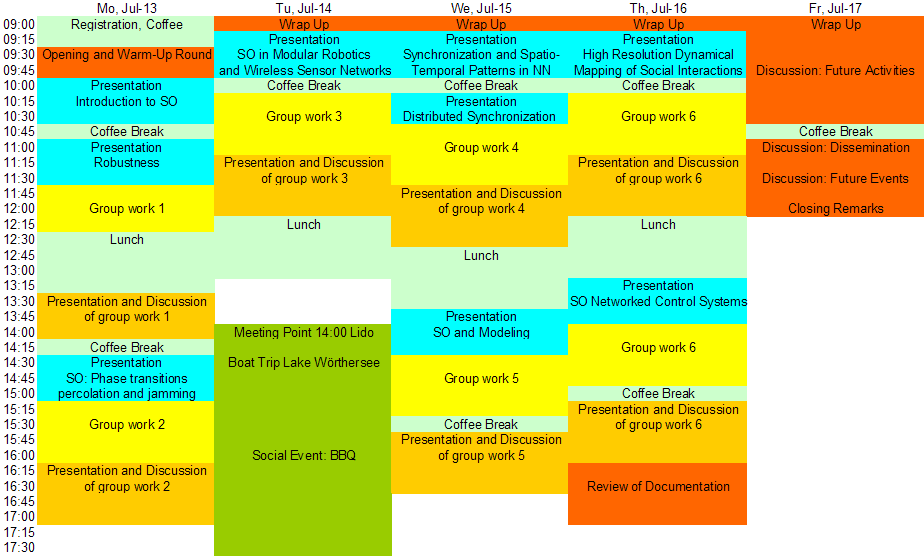Lakeside Research Days'09
Contents
- 1 Prolog
- 2 Research Days'09
- 3 Scheduled Talks
- 3.1 Robustness and Dependability
- 3.2 Introduction to Self-Organizing Systems
- 3.3 High resolution dynamical mapping of social interactions with active RFID
- 3.4 Self-Organizing Networked Control Systems
- 3.5 Vortrag Passau
- 3.6 Vortrag d'Souza
- 3.7 Synchronization and Spatio-Temporal Patterns in Neural Networks
Prolog
This meeting has been held on Friday, 19th of June 2009, 9AM - 1PM. The overall aim of this meeting was to collect ideas/problems which should be tackled during the Lakeside Research Days'09.
Participants: Christian Hofbauer (NES/ES), Alexander Onic (NES/ES), Markus Reichhartinger (SST/CM), Evsen Yanmaz (NES/MS), Johannes Klinglmayr (NES/MS), Istvan Fehervari (NES/MS), Kostyantyn Shchekotykhin (AINF/ISBI), Simon Triebenbacher (SST/AM), Markus Quaritsch (NES/PC), Helmut Adam (NES/MS), Laszlo Böszörmenyi (ITEC), Gerhard Friedrich (AINF/ISBI)
Research Days'09
The Lakeside Research Days 2009 take place as a five days workshop from July 13 to July 17, 2009.
Tentative workshop schedule:
Register to the workshop via doodle.
Scheduled Talks
Robustness and Dependability
W. Elmenreich
Introduction to Self-Organizing Systems
F. Heylighen
High resolution dynamical mapping of social interactions with active RFID
A. Barrat, C. Cattuto, V. Colizza, J-F Pinton, W. van den Broeck, A. Vespignani
In this paper we present an experimental framework to gather data on face-to-face social interactions between individuals, with a high spatial and temporal resolution. We use active Radio Frequency Identification (RFID) devices that assess contacts with one another by exchanging low-power radio packets. When individuals wear the beacons as a badge, a persistent radio contact between the RFID devices can be used as a proxy for a social interaction between individuals. We present the results of recent pilot studies performed during conferences, and a subsequent preliminary data analysis, that provides an assessment of our method and highlights its versatility and applicability in many areas concerned with human dynamics.
Self-Organizing Networked Control Systems
C. Zschoppe
Vortrag Passau
H. de Meer
Vortrag d'Souza
R. de Souza
Synchronization and Spatio-Temporal Patterns in Neural Networks
M. Timme
Patterns of precisely timed and spatially distributed spikes have been experimentally observed in different neuronal systems. These spike patterns correlate with external stimuli and internal states and are thus considered key features of neural computation. Their dynamical origin, however, is unclear. One possible explanation for their occurrence is the existence of excitatorily coupled feed-forward structures, synfire chains, which are embedded in a network of otherwise random connectivity and receive a large number of random external inputs. We here show how precise spike timing and temporal locking can naturally arise in the nonlinear dynamics of recurrent neural networks that contain no additionally embedded feed-forward structures.
